Creating levels using the Super Mario World method
A few years ago I wrote a book in which I analyzed all levels of the game Super Mario World (1990) . In it, I derived the system by which most of its levels were created. The game Super Mario World is a classic of the genre, it is in itself worth exploring. But the lessons she presents can be widely used today in game development. The Super Mario World method, or the Nintendo method, is actively used to create levels in a wide variety of games — even those that are not made by Nintendo.
In this lesson we will look at a simple form of content organization, which dates back to the 90s. As game developers (especially from Nintendo) improved their craft, they intuitively developed certain ways to organize content. I will try to explain how you can consciously use these intuitive tricks in your games.

Using this method, I created a demo level in Super Mario Maker with accompanying comments:
')
Level ID: 0740-0000-00CD-4D5B
The working title of the principle under consideration is “Test, modulation, series of obstacles”, or IMSP. To explain the principle of IMSP, I will use examples from Super Mario Maker. However, I saw how this principle is applied in Mega Man, Metroid, Portal, Half-Life, Super Meat Boy and many other games. Over time, you yourself will notice this method in your favorite games, as well as learn how to organize content and give more depth to your games.
To begin with, we will define the test. A test is a short task that must be performed completely and immediately; moments of relative calm follow and before the task. Take a look at the example below: Mario has to jump onto a moving platform over an abyss, and then jump off it.

On either side of the mobile platform is a land where you can be calm without endangering. But, jumping on the platform, the player must be careful not to fall into the abyss and not lose a life. Thus, this test begins and ends in safe areas to the left and right of the platform.
Complicate the test. I added a second mobile platform of a different type. The ground is still before and after the test, but there are already 2 platforms to overcome to cope with the task.
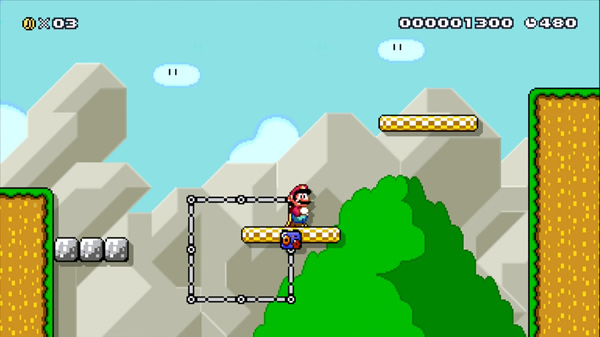
And although the second test is longer than the first, it is still the same test, because the player needs to overcome 2 platforms in one fell swoop before he gets to the safe section on the right.
Tests can be quite large, but they should always be separated from each other by small safe zones, where the player can literally take some time off before moving forward. Of course, in different games, the tests are different, with different duration. For example, in Sonic the Hedgehog, they are much longer than in Mario, because Sonic himself usually moves much faster, and the player needs extra space to slow down, stop or change direction. However, the principle remains the same.
It's one thing to know what trials are, and another is to understand how to fill the level with them correctly. The difficulty level must grow, otherwise the players will become bored. But at the same time, it is impossible to simply sketch out what kind of trials it is - the level must be complete. I think now is the time to talk about different types of tests and their interrelations.
Let's see how the 2 previous tests are related:
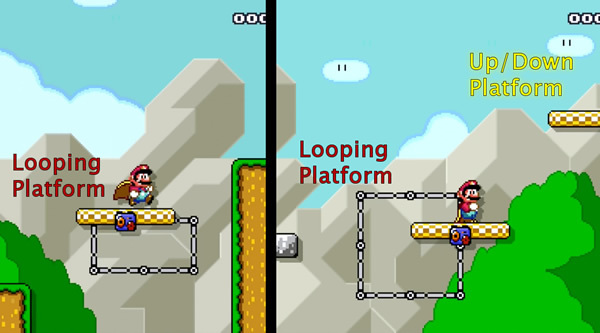
What is the difference between the first and second test? In both, moving platforms are used, but in the second there are not one, but 2 types of platforms that move along different trajectories and with different intervals. Accordingly, the complexity of this test is explained by the presence of a different type of platform.
When the difference between the two tests is to add a quality component, as in the example above, the second test is called the development of the first, since it is qualitatively more complicated than the first.
Here is another example of the add-on for clarity:
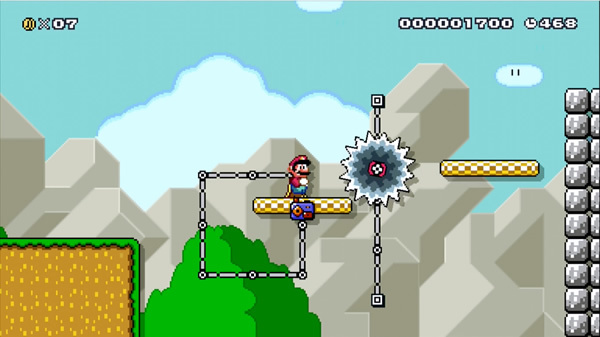
As you can see, I just added an additional obstacle; it moves vertically between the platforms. This is another example of a qualitative increase in complexity. In such a situation, it will be even more difficult for the player to find the necessary period of time to take the jump.
Of course, the complexity has not increased significantly. In Nintendo they prefer to complicate their games gradually, step by step. By the end of a difficult level, the additions reach their peak and give birth to the most difficult trials. But the principle is always the same: one addition in one step.
There is another way to increase the complexity of the tests, while not violating the original concept of the level. In the example below, I repeated the first test, but with one significant difference.
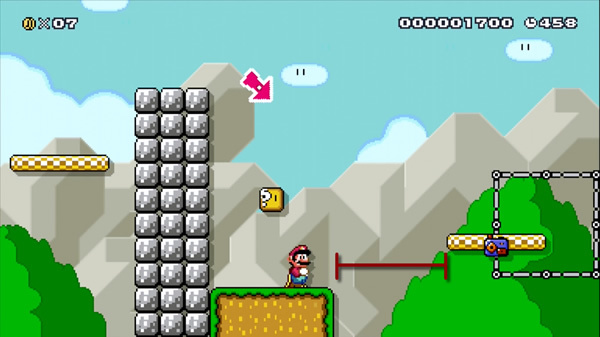
I increased the distance between the ground and the moving platform. Since Mario now needs to jump a greater distance, the difficulty of the jump has increased. I call this method an extension of the test.
Expansion is a quantitative change to the components of the test. In this case, I increased the distance to the platform 3 times. Consider another expansion example:
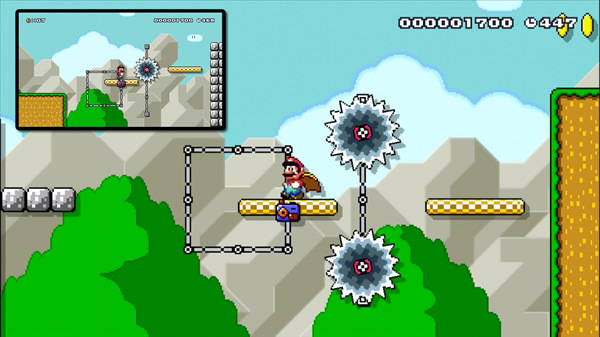
This test is similar to the second addition presented above, but here I have increased the number of obstacles between the platforms. It is more difficult to make the jump, as it is more difficult to catch the right moment for him - all thanks to a simple quantitative change: 2 grinders instead of one.
Expansion tests are very easy to create, as you only need to duplicate any component of the previous test. For this reason, inexperienced designers often go too far with the extension (we will return to this issue in the next lesson).
Before you start experimenting with additions and extensions, you should consider a couple more recommendations.
First, in Mario (and its successors), add-ons do not overlap in a linear fashion. Instead, complex tests often return to their original positions, and then the order and principle of application of supplements change.
Here is an example of this behavior:

Instead of further increasing the complexity of the level by constantly adding new platforms, I decided to go a different way. I turned the ring path of the initial platform into a linear one. Now Mario must jump not from platform to platform, but through obstacles.
The required skill has not changed - it is necessary to do jumps in time; but this is a qualitatively different direction. The next few tests will use this direction as a basis for further complication.
This example develops the previous idea:
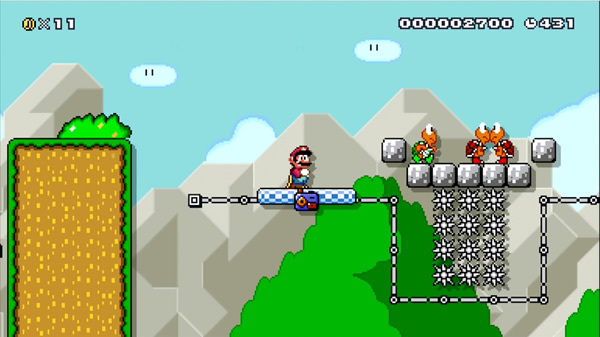
It is not difficult to guess that this test combines both qualitative and quantitative changes of the previous one. Complicated trajectory is a qualitative change, and additional opponents are quantitative. It turns out that we simultaneously applied both addition and extension.
In Super Mario World, both compound tests and those using only one of the mentioned techniques are equally found.
In the last example, the platform reappears with a circular path:

There are a certain idea that 2 separate branches with different variants of additions were collected at the end of the level together. Together they form a climax change.
It's time to talk about modulations. In a broad sense, it is a way of interconnecting all the tests of one level
To make it clearer, I created a diagram that demonstrates how my level works:
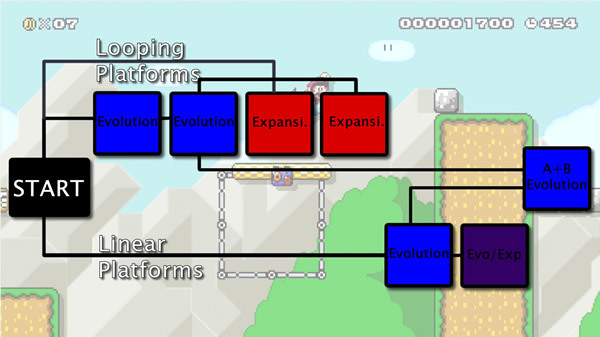
As you can see, the level is divided into 3 branches with additions, which makes this type of modulation look like a fork, at the end of which there is a combination.
Nintendo games and even Super Mario World itself use many types of modulations:

There are many other types that developers use in their games. This means that modulations in no way limit your creative potential as a level designer - on the contrary, they enrich it.
The IMSP principle helps designers and developers organize and streamline the creative process of creating levels. Add-ons and extensions can be applied in any game or game mechanics, and modulations are used to understand the naturally occurring patterns of level modeling.
Although all the concepts discussed above were stated as part of my research, everything that I told in this article (and I will tell in subsequent ones) arose and developed in the classic video games in a natural way. The theory is just as important as practice, and there is no perfect recipe for level design. But there are many useful recommendations, and the principle of IHR also applies to them. If you are looking for a way to streamline and streamline your workflow, this is what you need.
In this lesson we will look at a simple form of content organization, which dates back to the 90s. As game developers (especially from Nintendo) improved their craft, they intuitively developed certain ways to organize content. I will try to explain how you can consciously use these intuitive tricks in your games.

My example
Using this method, I created a demo level in Super Mario Maker with accompanying comments:
')
Level ID: 0740-0000-00CD-4D5B
Test, Modulation, Obstacle Series
The working title of the principle under consideration is “Test, modulation, series of obstacles”, or IMSP. To explain the principle of IMSP, I will use examples from Super Mario Maker. However, I saw how this principle is applied in Mega Man, Metroid, Portal, Half-Life, Super Meat Boy and many other games. Over time, you yourself will notice this method in your favorite games, as well as learn how to organize content and give more depth to your games.
Tests
To begin with, we will define the test. A test is a short task that must be performed completely and immediately; moments of relative calm follow and before the task. Take a look at the example below: Mario has to jump onto a moving platform over an abyss, and then jump off it.

On either side of the mobile platform is a land where you can be calm without endangering. But, jumping on the platform, the player must be careful not to fall into the abyss and not lose a life. Thus, this test begins and ends in safe areas to the left and right of the platform.
Complicate the test. I added a second mobile platform of a different type. The ground is still before and after the test, but there are already 2 platforms to overcome to cope with the task.

And although the second test is longer than the first, it is still the same test, because the player needs to overcome 2 platforms in one fell swoop before he gets to the safe section on the right.
Tests can be quite large, but they should always be separated from each other by small safe zones, where the player can literally take some time off before moving forward. Of course, in different games, the tests are different, with different duration. For example, in Sonic the Hedgehog, they are much longer than in Mario, because Sonic himself usually moves much faster, and the player needs extra space to slow down, stop or change direction. However, the principle remains the same.
We add tests
It's one thing to know what trials are, and another is to understand how to fill the level with them correctly. The difficulty level must grow, otherwise the players will become bored. But at the same time, it is impossible to simply sketch out what kind of trials it is - the level must be complete. I think now is the time to talk about different types of tests and their interrelations.
Additions
Let's see how the 2 previous tests are related:

What is the difference between the first and second test? In both, moving platforms are used, but in the second there are not one, but 2 types of platforms that move along different trajectories and with different intervals. Accordingly, the complexity of this test is explained by the presence of a different type of platform.
When the difference between the two tests is to add a quality component, as in the example above, the second test is called the development of the first, since it is qualitatively more complicated than the first.
Here is another example of the add-on for clarity:

As you can see, I just added an additional obstacle; it moves vertically between the platforms. This is another example of a qualitative increase in complexity. In such a situation, it will be even more difficult for the player to find the necessary period of time to take the jump.
Of course, the complexity has not increased significantly. In Nintendo they prefer to complicate their games gradually, step by step. By the end of a difficult level, the additions reach their peak and give birth to the most difficult trials. But the principle is always the same: one addition in one step.
Extensions
There is another way to increase the complexity of the tests, while not violating the original concept of the level. In the example below, I repeated the first test, but with one significant difference.

I increased the distance between the ground and the moving platform. Since Mario now needs to jump a greater distance, the difficulty of the jump has increased. I call this method an extension of the test.
Expansion is a quantitative change to the components of the test. In this case, I increased the distance to the platform 3 times. Consider another expansion example:

This test is similar to the second addition presented above, but here I have increased the number of obstacles between the platforms. It is more difficult to make the jump, as it is more difficult to catch the right moment for him - all thanks to a simple quantitative change: 2 grinders instead of one.
Expansion tests are very easy to create, as you only need to duplicate any component of the previous test. For this reason, inexperienced designers often go too far with the extension (we will return to this issue in the next lesson).
Addition, expansion and return
Before you start experimenting with additions and extensions, you should consider a couple more recommendations.
First, in Mario (and its successors), add-ons do not overlap in a linear fashion. Instead, complex tests often return to their original positions, and then the order and principle of application of supplements change.
Here is an example of this behavior:

Instead of further increasing the complexity of the level by constantly adding new platforms, I decided to go a different way. I turned the ring path of the initial platform into a linear one. Now Mario must jump not from platform to platform, but through obstacles.
The required skill has not changed - it is necessary to do jumps in time; but this is a qualitatively different direction. The next few tests will use this direction as a basis for further complication.
This example develops the previous idea:

It is not difficult to guess that this test combines both qualitative and quantitative changes of the previous one. Complicated trajectory is a qualitative change, and additional opponents are quantitative. It turns out that we simultaneously applied both addition and extension.
In Super Mario World, both compound tests and those using only one of the mentioned techniques are equally found.
In the last example, the platform reappears with a circular path:

There are a certain idea that 2 separate branches with different variants of additions were collected at the end of the level together. Together they form a climax change.
Modulations
It's time to talk about modulations. In a broad sense, it is a way of interconnecting all the tests of one level
To make it clearer, I created a diagram that demonstrates how my level works:

As you can see, the level is divided into 3 branches with additions, which makes this type of modulation look like a fork, at the end of which there is a combination.
Nintendo games and even Super Mario World itself use many types of modulations:

There are many other types that developers use in their games. This means that modulations in no way limit your creative potential as a level designer - on the contrary, they enrich it.
The IMSP principle helps designers and developers organize and streamline the creative process of creating levels. Add-ons and extensions can be applied in any game or game mechanics, and modulations are used to understand the naturally occurring patterns of level modeling.
Conclusion
Although all the concepts discussed above were stated as part of my research, everything that I told in this article (and I will tell in subsequent ones) arose and developed in the classic video games in a natural way. The theory is just as important as practice, and there is no perfect recipe for level design. But there are many useful recommendations, and the principle of IHR also applies to them. If you are looking for a way to streamline and streamline your workflow, this is what you need.
Source: https://habr.com/ru/post/307428/
All Articles